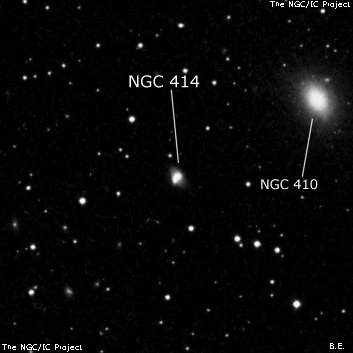
Herman Schultz discovered NGC 414 = Nova IV on 15 Oct 1866 with the 9.6-inch refractor at Uppsala Observatory. His micrometric position matches UGC 744 = PGC 4254. This appears to be the only galaxy in the NGC that Schultz was first to discover. He independently discovered NGC 20, but it was discovered earlier at Birr Castle. His GC 5096 [later NGC 90] was also found earlier at Birr Castle (GC 40). His GC 6153 [later NGC 7553] was discovered earlier (GC 4913) by Lord Rosse assistant George Stoney and finally NGC 7571 is probably a duplicate of NGC 7597, discovered earlier by Albert Marth. All of his other NGC objects are single or double stars.
This is a double or merged system with two nuclei. The companion on the southeast side is catalogued separately as PGC 93079. Based on Crossley photographs at Lick Observatory, Heber Curtis described NGC 414 as "very small, binuclear. The almost stellar nuclei are 7" apart in p.a. 142°."
300/350mm - 13.1" (9/29/84): faint, thin streak NW-SE, weak concentration.
400/500mm - 17.5" (12/23/89): fairly faint, small, elongated NW-SE. Third of three with NGC 410 5' NW and NGC 407 8.4' W. NGC 414 consists of a merged pair of compacts, though they were not resolved.
600/800mm - 24" (12/12/17): at 375x; moderately bright, fairly small, elongated 21"x14" NW-SE with a very faint halo extending SW-NE. This is a merged double system with twin nuclei NW-SE, separated by only ~7". I suspected it to be double at 375x and it was definitely "resolved" at 500x. The brighter NW nucleus (higher surface brightness) was ~6" diameter and appeared more centered in the halo. The southeast nucleus (~5" diameter) was nearly attached as a round, tiny "bulge" or knot.
Notes by Steve Gottlieb